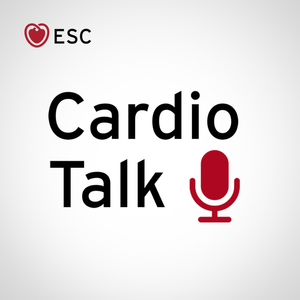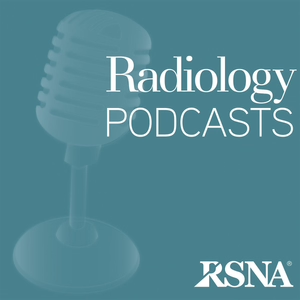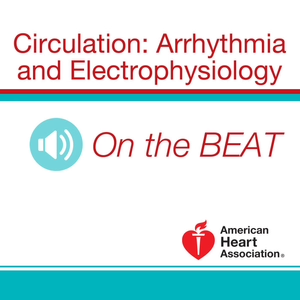
Circulation: Arrhythmia and Electrophysiology on the Beat July 2018
07/17/18 • 16 min
Dr Paul Wang: Welcome to the monthly podcast, On the Beat for Circulation: Arrhythmia and Electrophysiology. I'm Dr Paul Wang, Editor-in-Chief, with some of the key highlights from this month's issue.
In our first paper this month, Shaan Khurshid and associates determine the frequency of rhythm abnormalities in 502,627 adults in the UK Biobank, a national prospective cohort. They found that 2.35% had a baseline rhythm abnormality. The prevalence increased with age, with 4.84% of individuals aged 65 to 73 years having rhythm abnormalities. During over three million person- years of follow up, nearly 16,000 new rhythm abnormalities were detected. Atrial fibrillation was the most frequent with three per thousand person-years. Bradyarrhythmia with almost one per thousand person-years. Conduction system disease is about one per one thousand years. Supraventricular and ventricular arrhythmias, each about one half per one thousand person-years. Older age was associated with a hazard ratio of 2.35 for each 10 year increase. Male sex, hypertension, chronic kidney disease and heart failure were all associated with new rhythm abnormalities.
In our next paper, Fabien Squara and associates evaluated a method of determining the septal or free wall positioning of pacemaker or ICD leads during fluoroscopy. They compared in 50 patients a classical approach using posterior anterior, right anterior oblique 30 degrees, and left anterior oblique 40 degrees fluoroscopic imaging’s to 50 patients undergoing an individualized left anterior oblique or LAO approach. This individualized LAO approach view provided a true view of the interventricular septum. This angle was defined by the degree of LAO that allowed the perfect superimposition of the RV apex, using the tip of the right ventricular lead, temporarily placed at the apex, and one of the superior vena cava, inferior vena cava access using a guide wire. Transthoracic echo was used to confirm position of the right ventricular lead.
Septal, or free wall, right ventricular lead positioning was correctly identified in 96% of patients in the individualized group, versus 76% in the classical group. P equals 0.004. For septal lead positioning fluoroscopy had 100% sensitivity, and an 89.5 specificity in an individualized group, versus 91.4% sensitivity, and a 40% specificity in the classical group.
In our next paper, Elsayed Soliman and associates examined the lifetime risk of atrial fibrillation based on race and socioeconomic status. In the atherosclerosis risk in communities, ARIC, cohort, of 15,343 participants without atrial fibrillation, patients were recruited in 1987 to 1989, when they were 45 to 64 years of age, and followed through 2014. The authors identify 2,760 atrial fibrillation cases during a mean follow up of 21 years. The authors found that the lifetime risk of atrial fibrillation in the ARIC cohort was approximately one in three among whites, and one in five among African Americans. And, the socioeconomic status was inversely associated with cumulative incidents of atrial fibrillation before the last decades of life.
In our next paper, Jonathan Steinberg and associates sought to determine the impact of atrial fibrillation episode duration threshold on atrial fibrillation incidents and burden in pacemaker patients in a prospective registry. In 615 pacemaker patients was device detected atrial fibrillation over a mean follow up of 3.7 years, 599 had one or more atrial fibrillation episodes of 30 seconds duration, with a mean number of 22 episodes. At 12 months, freedom from atrial fibrillation ranged from 25.5% to 73.1%, based on a duration threshold from 30 seconds up to 24 hours. Of patients with a first episode of 30 seconds to two minutes, 35.8% were free from subsequent episodes greater than two minutes at 180 days. The mean atrial fibrillation burden of 0.2% for patients with first episodes between 30 seconds and 3.8 hours, was significantly less than the 9.5% burden for those with greater than 3.8 hours.
The authors concluded that small differences in atrial fibrillation episode duration definition can significantly affect the perceived incidents of atrial fibrillation impact reported outcomes, including atrial fibrillation success. An initial atrial fibrillation episode of 30 seconds does not predict clinically meaningful atrial fibrillation burden.
In the next paper, Hongwu Chen and Linsheng Shi and associates examined the distinct electrophysiologic features of bundle branch reentrant ventricular tachycardia in patients without structural heart disease. They described nine patients, mean age 29.6 years, with normal left ventricular function and bundle branch reentrant ventricular tachycardia, with a right bundle branch block pattern in one patient, and left bundle branch block patterns in nine patients. In all left bundle branch block pattern ventricular tachycardia, the mean ventricular tachycardia cyc...
Dr Paul Wang: Welcome to the monthly podcast, On the Beat for Circulation: Arrhythmia and Electrophysiology. I'm Dr Paul Wang, Editor-in-Chief, with some of the key highlights from this month's issue.
In our first paper this month, Shaan Khurshid and associates determine the frequency of rhythm abnormalities in 502,627 adults in the UK Biobank, a national prospective cohort. They found that 2.35% had a baseline rhythm abnormality. The prevalence increased with age, with 4.84% of individuals aged 65 to 73 years having rhythm abnormalities. During over three million person- years of follow up, nearly 16,000 new rhythm abnormalities were detected. Atrial fibrillation was the most frequent with three per thousand person-years. Bradyarrhythmia with almost one per thousand person-years. Conduction system disease is about one per one thousand years. Supraventricular and ventricular arrhythmias, each about one half per one thousand person-years. Older age was associated with a hazard ratio of 2.35 for each 10 year increase. Male sex, hypertension, chronic kidney disease and heart failure were all associated with new rhythm abnormalities.
In our next paper, Fabien Squara and associates evaluated a method of determining the septal or free wall positioning of pacemaker or ICD leads during fluoroscopy. They compared in 50 patients a classical approach using posterior anterior, right anterior oblique 30 degrees, and left anterior oblique 40 degrees fluoroscopic imaging’s to 50 patients undergoing an individualized left anterior oblique or LAO approach. This individualized LAO approach view provided a true view of the interventricular septum. This angle was defined by the degree of LAO that allowed the perfect superimposition of the RV apex, using the tip of the right ventricular lead, temporarily placed at the apex, and one of the superior vena cava, inferior vena cava access using a guide wire. Transthoracic echo was used to confirm position of the right ventricular lead.
Septal, or free wall, right ventricular lead positioning was correctly identified in 96% of patients in the individualized group, versus 76% in the classical group. P equals 0.004. For septal lead positioning fluoroscopy had 100% sensitivity, and an 89.5 specificity in an individualized group, versus 91.4% sensitivity, and a 40% specificity in the classical group.
In our next paper, Elsayed Soliman and associates examined the lifetime risk of atrial fibrillation based on race and socioeconomic status. In the atherosclerosis risk in communities, ARIC, cohort, of 15,343 participants without atrial fibrillation, patients were recruited in 1987 to 1989, when they were 45 to 64 years of age, and followed through 2014. The authors identify 2,760 atrial fibrillation cases during a mean follow up of 21 years. The authors found that the lifetime risk of atrial fibrillation in the ARIC cohort was approximately one in three among whites, and one in five among African Americans. And, the socioeconomic status was inversely associated with cumulative incidents of atrial fibrillation before the last decades of life.
In our next paper, Jonathan Steinberg and associates sought to determine the impact of atrial fibrillation episode duration threshold on atrial fibrillation incidents and burden in pacemaker patients in a prospective registry. In 615 pacemaker patients was device detected atrial fibrillation over a mean follow up of 3.7 years, 599 had one or more atrial fibrillation episodes of 30 seconds duration, with a mean number of 22 episodes. At 12 months, freedom from atrial fibrillation ranged from 25.5% to 73.1%, based on a duration threshold from 30 seconds up to 24 hours. Of patients with a first episode of 30 seconds to two minutes, 35.8% were free from subsequent episodes greater than two minutes at 180 days. The mean atrial fibrillation burden of 0.2% for patients with first episodes between 30 seconds and 3.8 hours, was significantly less than the 9.5% burden for those with greater than 3.8 hours.
The authors concluded that small differences in atrial fibrillation episode duration definition can significantly affect the perceived incidents of atrial fibrillation impact reported outcomes, including atrial fibrillation success. An initial atrial fibrillation episode of 30 seconds does not predict clinically meaningful atrial fibrillation burden.
In the next paper, Hongwu Chen and Linsheng Shi and associates examined the distinct electrophysiologic features of bundle branch reentrant ventricular tachycardia in patients without structural heart disease. They described nine patients, mean age 29.6 years, with normal left ventricular function and bundle branch reentrant ventricular tachycardia, with a right bundle branch block pattern in one patient, and left bundle branch block patterns in nine patients. In all left bundle branch block pattern ventricular tachycardia, the mean ventricular tachycardia cyc...
Previous Episode
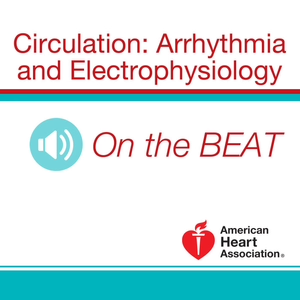
Circulation: Arrhythmia and Electrophysiology On the Beat June 2018
Dr Paul Wang: Welcome to the monthly podcast, On the Beat, for Circulation: Arrhythmia and Electrophysiology. I'm Dr Paul Wang, editor-in-chief, with some of the key highlights from this month's issue.
Dr Paul Wang: In our first paper, Farhad Pashakhanloo and associates examine the three-dimensional structure of the healed infarct and the ventricular tachycardia reentrant pathways in high-resolution models of infarcted porcine hearts. The authors used ex vivo late gadolinium enhancement in diffusion tensor MRI data of eight chronically infarcted porcine hearts at sub-millimeter resolution in a novel scar map thickness metric to reveal the heterogeneous organization of infarct. The authors use simulation to model ventricular tachycardia pathways. They found that a surviving sub-endocardial tissue later of varying thickness less than or equal to 2.2 millimeters surrounding the scar participated in the majority of ventricular tachycardias. The authors concluded that these analyses provided a better understanding of infarc-related ventricular tachycardia.
Dr Paul Wang: In our next paper, Thomas Hadberg Lynge and associates studied the incidence of sudden cardiac death in a population of congenital heart disease in Denmark. Among 24.4 million person years over a nine-year period, there were 11,451 deaths that were examined. Of 809 cases of sudden cardiac death, 90, or 11% of the cases, were from congenital heart disease. Of these cases, 53, or 59% had the diagnosis of congenital heart disease prior to death. The incidence of sudden cardiac death was 9.6 times higher among patients with congenital heart disease compared to patients without congenital heart disease, p
Next Episode
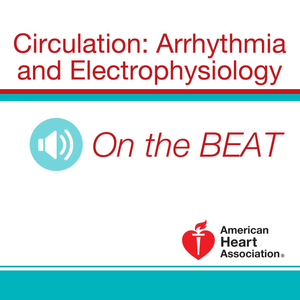
Circulation: Arrhythmia and Electrophysiology August 2018 Issue
Paul Wang: Welcome to the monthly podcast, On the Beat for Circulation: Arrhythmia and Electrophysiology. I'm Dr Paul Wang, editor-in-chief, with some of the key highlights from this month's issue. In our first paper from the Finland Group Registry, Nordenswan and her colleagues have further defined the risk of sudden cardiac death in ventricular arrhythmias in patients with cardiac sarcoidosis. While it has been observed that there's a high risk of lethal arrhythmias in cardiac sarcoidosis patients with high grade AV block, the incidents in these patients with lone AV block, in the absence of known VT or left ventricular dysfunction, has not been described. From the patients with myocardial inflammatory diseases in their registry, the authors identified 143 cardiac sarcoidosis patients with high grade AV block. Of these patients, 90 had lone AV block. For these patients, the five-year composite incidence of sudden cardiac death or VT was 24%, in comparison with 54% in AV block with ventricular tachycardia or severe left ventricular dysfunction, and 24% with AV block in non-severe left ventricular dysfunction.
These findings support implementation of an implantable cardioverter defibrillator for cardiac sarcoidosis patients with lone AV block. A recent study by Gold and Colleagues suggests atrial ventricular optimization improves reverse remodeling in patients with significant intraventricular electrical delay. In this sub-study of the Smart AV Trial, 275 subjects were randomized to either electrogram-based AV optimization, smart delay, or nominal AV delay, 120 milliseconds. In this mostly male cohort, with a mean age of 65 years, and a left ventricular ejection fraction of 28% at follow up, at six months the benefit of AV optimization increased as intraventricular electrical delay prolonged, defined as the time between the peaks of the right and left ventricular electrograms. The longest cohort trial of intraventricular conduction delay had 4.26 times greater odds of remodeling response with AV optimization compared with nominal AV delay. This suggests that the left ventricular lead position in AV optimization might have a synergistic effect in reverse remodeling in cardiac resynchronization patients.
Concerns have long been raised that anorexia nervosa causes QT interval prolongation predisposing these individuals to life-threatening ventricular arrhythmias and sudden cardiac death. Fredrickson and Associates made progress in challenging this conclusion, demonstrating that despite a slightly increased incidence in borderline mean QTC, greater than 440 milliseconds, in 430 female anorexia nervosa patients, compared to 123 healthy controls from the Danish Civil Register, there was no difference in the risk of prolonged corrected QT interval greater than 460 milliseconds between the two groups.
However, during a 10-year follow up, anorexia nervosa patients had a slightly increased risk of ventricular tachycardiac, aborted cardiac arrest, and cardiac arrest compared to healthy controls. Incidence of 0.5% in the anorexia nervosa patients versus 0.07% in healthy controls. In addition, anorexia nervosa patients had a significantly increased risk of all-cause mortality with a hazard ratio of 11.2 over 10 years compared to population-based cohort, suggesting that anorexia nervosa increases the risk of medical complications, including cardiac complications, but these are not directly related to anorexia nervosa's effects on corrected QT interval.
In our next paper, Ahmed Karim Talib and Associates reported on the outcomes of endocardial ablation of drug-resistant ventricular fibrillation in Brugada syndrome. Endocardial mapping ablation was performed in 21 patients with one or more episodes of ventricular fibrillation. Endocardial mapping revealed low voltage fractionated endocardial electrograms in 19% of patients. All patients underwent ablation of ventricular fibrillation triggers, followed by endocardial substrate modification. Noninducibility of ventricular fibrillation and normalization of Brugada ECG was documented in 14, in three patients, respectively. During a mean follow up of 54 months, seven patients, or 33%, experienced ventricular fibrillation recurrences, presence of cruris notching in D1 was associated with the presence of low-voltage fractionated endocardial electrograms in ablation failure.
In our next paper, Jae Yeong Cho and Associates tried to elucidate the mechanism of sudden cardiac death in patients with heart failure with preserved ejection fraction using an ambulatory recording in a rat model. They showed that rats who had a clinical phenotype of heart failure with preserved ejection fraction had prolonged QT and QTC intervals and reduced heart rate variability compared to the controls. Importantly, the rats with heart failure and preserved ejection fraction had significantly higher rates of spontaneous ventricular arrhythmias, and about a t...
If you like this episode you’ll love
Episode Comments
Generate a badge
Get a badge for your website that links back to this episode
<a href="https://goodpods.com/podcasts/circulation-arrhythmia-and-electrophysiology-on-the-beat-94401/circulation-arrhythmia-and-electrophysiology-on-the-beat-july-2018-5066089"> <img src="https://storage.googleapis.com/goodpods-images-bucket/badges/generic-badge-1.svg" alt="listen to circulation: arrhythmia and electrophysiology on the beat july 2018 on goodpods" style="width: 225px" /> </a>
Copy

